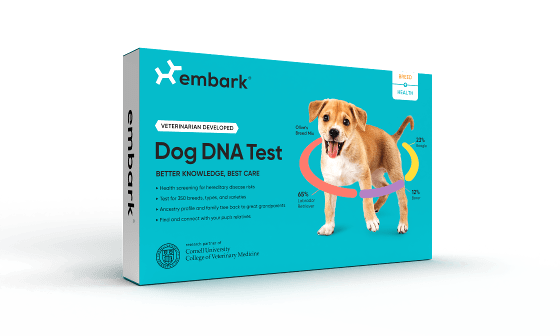Your dog is one-of-a-kind. But have you ever wondered what makes them that way? Embark makes it our business to know your dog down to their DNA. Our scientists unlocked a secret to understanding dogs’ roan coat patterns — and they couldn’t have done it without the help of everyday dog owners who wanted to make a difference.
A new discovery: roan in dogs
Embark scientists worked in collaboration with its citizen scientist customers to make the unique genetic discovery that the patterned coat that is known as “roaning” is strongly associated with a genomic region on chromosome 38 and likely regulated by the usherin gene (USH2A).
This type of subtly spotted coat, found in dogs and horses, can act as nature’s camouflage. Roaning can make dogs more difficult to see in fields or forests, a trait that is particularly desirable in certain hunting dogs. Roaning is common in certain breeds, including German Shorthaired Pointers, Australian Cattle Dogs, and English Cocker Spaniels.
Embark scientists studied the genotype and physical appearance of nearly 1,000 dogs. One of those dogs, Bogey the Australian Cattle Dog, became the key to unlocking this genetic discovery because of his atypical non-roan coat trait. Bogey’s owner chose to include Bogey’s genotype in Embark’s research and also provided Embark with a photo, which is part of what made this novel discovery possible.
The dog owners participating in this study became part of a larger trend toward crowd-sourced scientific discovery. Similar work from other “citizen scientists” have already contributed to significant discoveries in astronomy and ornithology.
A clue to the Dalmatian’s spots
The results of this study may also shed light on the genetic origin of the Dalmatian’s unique spots. Until now, the spots on Dalmatians have been considered different and distinct from roaning (both genetically and visually). However, all Dalmatians in the Embark study carried the duplication associated with roaning. This suggests that Dalmatians and dogs with roaning may share common ancestry (although more research is needed in this area).
While dogs can’t have roaning without the white spotting pattern caused by the S Locus (MITF gene), the white spotting (specifically piebald an extreme white) does come with some associated health risks, like deafness. Pigment-associated deafness has been observed in many breeds, but the exact genetic mechanism is unclear and suggested to be complex.
Did you know? Embark also discovered a genetic variant associated with early-onset adult deafness in Rhodesian Ridgebacks.
Roan testing only at Embark
Embark is the only dog DNA test on the market that provides a genetic test for roaning. In addition to roaning, Embark tests for 350+ breeds and 270+ genetic health risks. A market leader in canine genetics, Embark also offers the world’s only canine DNA Relative Finder and Matchmaker for breeders.
Testing for the roaning genetic trait is available with any Embark test that includes health and trait testing.
Learn more about Embark’s roaning discovery or check out the full study in the peer-reviewed journal PLOS One.
Already tested your dog with Embark? Please be sure to take our surveys under the Research tab in your dog’s Embark profile so you can help contribute to new scientific discoveries.









